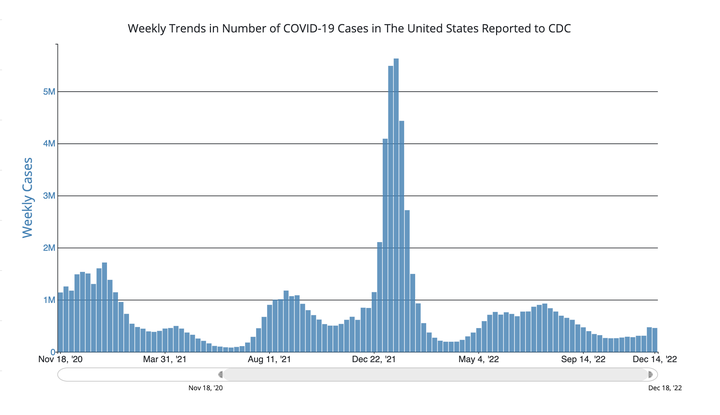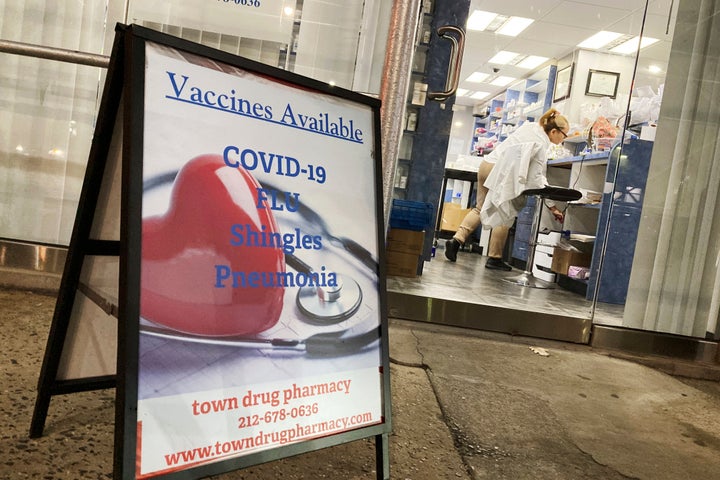COVID In 2023: Here’s What Experts Expect
It’s been three years since the novel coronavirus first emerged, and while a sense of normalcy may have returned for many people, experts say the pandemic isn’t over yet.
COVID-19 cases and hospitalizations remain ever present in the U.S., and experts warn of more powerful variants emerging as the virus continues to spread and mutate globally. At the same time, researchers are working on what they hope will be more effective vaccine methods and treatments for both the acute disease and the lingering, long-term effects of long COVID.
Here is some of what we can expect to see this year.
‘An airplane of people falling out of the sky every day’
The number of COVID-19 cases reported in the U.S. has so far stayed relatively flat this winter compared to prior years, but cases are expected to rise due to recent indoor holiday gatherings. Case counts are also likely being underreported because more people are doing rapid testing at home, said Dr. Susan Hassig, an epidemiology professor at Tulane University whose research areas include infectious disease outbreaks.
“It’s probably 10 times or 15 times higher at the minimum than what we’re measuring right now,” she said of current national counts, which are tallied from tests performed by hospitals and other health care providers. “Rapid tests don’t get reported, so we don’t have a good view into the actual level of infection that exists in the United States.”

There are also concerns that COVID-19 hospitalizations could dramatically rise because fewer people have received the updated bivalent vaccine booster, which is specifically designed to protect against COVID-19 caused by the omicron variant and the original virus strain.
As of early January, omicron descendants made up the majority of cases in the U.S., according to the Centers for Disease Control and Prevention, though only 15% of the U.S. population has received an updated booster shot.
One of the most dominant new descendants, XBB.1.5, was last week called “the most transmissible variant” yet by the World Health Organization. Data on its severity was not immediately available, though there was no early indication that severity had changed judging by lab studies and current hospitalization rates, said the WHO’s senior epidemiologist Maria Van Kerkhove at a press conference.
“Omicron is highly transmissible and fewer people are protected against that right now. So that doesn’t bode well,” Dr. Thomas A. LaVeist, dean of the Tulane University School of Public Health and Tropical Medicine, said of current vaccination rates for bivalent COVID-19 boosters. “I think we’re likely headed for headwinds because we’ve let our guard down.”
“We in America need to remember that COVID isn’t over,” said Hassig. “We are still losing the equivalent of an airplane of people falling out of the sky every day from COVID.”
An average of 385 people died each day from the virus last month, according to CDC data.
An annual vaccine?
White House officials last fall suggested that COVID-19 vaccinations may become annual for most people, similar to flu shots.
This would depend on a “dramatically different variant” not emerging and upending the current vaccines’ effectiveness, said Dr. Anthony Fauci, the White House’s then-chief medical adviser. Individuals with underlying health conditions may still need to get vaccinated more than once a year, he added.
A single combined COVID-19 and influenza vaccine is also in the works, with Moderna, Pfizer-BioNTech and Novavax all launching trials last year. Moderna has said it hopes to market its single shot, which would also include a vaccine for respiratory syncytial virus, or RSV, by the fall of 2023.

Hassig said she personally hopes “booster” shots are replaced with one annual shot, simply because it could be an easier ask for the public.
“I would rather just increase the likelihood that they would get it on an annual basis,” she said. “It just will become something that we have to factor into our kind of preventive medicine approach to keeping ourselves healthy and taking care of ourselves and our families on an annual basis.”
A move away from needles?
As for whether annual vaccines could one day no longer be needed for COVID-19, that’s looking unlikely, at least for the foreseeable future. That’s in part because of how quickly RNA viruses like SARS-CoV-2 ― the virus that causes COVID-19 ― and influenza mutate, which can lead to vaccine resistance, said Hassig.
“This virus mutates as it moves from person to person to person,” she said. “That’s the challenge with these…
Read More: COVID In 2023: Here’s What Experts Expect

